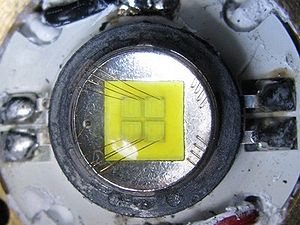LED: Difference between revisions
fix Lumileds link |
|||
| Line 5: | Line 5: | ||
==LED Manufacturers== | ==LED Manufacturers== | ||
[[Cree]], [[Luminus]], [[Nichia]], [[Osram]], [[ | [[Cree]], [[Luminus]], [[Nichia]], [[Osram]], [[Philips Lumileds|Philips Lumileds (Luxeon)]], [[Seoul Semiconductor]] | ||
[http://www.candlepowerforums.com/vb/showthread.php?t=270419 CPF Post] with pictures of common flashlight LED's | [http://www.candlepowerforums.com/vb/showthread.php?t=270419 CPF Post] with pictures of common flashlight LED's | ||
Revision as of 03:21, 3 January 2011

An LED (Light Emitting Diode) is a type of solid-state lighting. In keeping with the properties of a diode, electric current can only flow one direction through an LED. As the electrons cross from a material abundant in negative charge carriers to a material abundant in positive carriers active region, they lose a specific amount of energy, which results in photons of a particular wavelength. Different semiconductors used in the manufacture of LEDs will result in different wavelengths (colors) of light emitted. Currently, the brightest semiconductor materials are Aluminum Indium Gallium Phosphide (AlInGaP) for reds, oranges, ambers and yellows, and Indium Gallium Nitride (InGaN) for blues and greens. A white LED is typically a blue LED coated in a yellow emitting phosphor (this is why flashlight LED's appear yellow when they are off), or combination of phosphors, which are excited by the blue light and produce light as a result. When this yellow light mixes with the blue light from the LED, the combined light appears white to the human eye.
LED Manufacturers
Cree, Luminus, Nichia, Osram, Philips Lumileds (Luxeon), Seoul Semiconductor
CPF Post with pictures of common flashlight LED's
Driving the LED
As the available voltage to a LED increases, the current (in amps or milliamps) drawn by the LED increases. LED's are usually more efficient at lower voltages and currents, but get brighter as more power (power being volts times amps and measured in watts) is applied. LED's are evaluated at different currents and a forward voltage (or Vf) is measured as the voltage drop across the LED at a particular current level, 350mA or 700mA being pretty common benchmarks. In flashlights, an electronic driver is there to regulate the amount of power delivered to the LED either by controlling the voltage and/or current to the LED.
As more power is applied, more waste heat is generated and must be carried off. At some point a LED will be overdriven which will shorten its life from the tens of thousands of hours a properly driven LED should last. As the LED is overdriven the yellow phosphor on the LED starts to burn and "angry blue" light is emitted. If the light is turned off quickly, the LED may avoid permanent damage, but otherwise the LED will literally burn with brown spots on the LED. Generally when that happens, the maximum output will now be significantly lower.
LED's in Flashlights
Early LED's did not give off that much light, but they were efficient and they would last many thousands of hours before burning out. As they got brighter, they started making their way into flashlights. The classic LED's were 5mm in diameter encased in clear epoxy resin with a round head. As the LED inside gave off light, the rays were shaped by the round head to go straight ahead. Many keychain flashlights use a simple LED like that. These are usually named as 3 mm or 5 mm LED's. The Fenix E01 uses a 5mm Nichia LED. To get additional brightness, some flashlights would combine multiple LED's in the head of the flashlight and maybe include some kind of reflector to shape the light.

High power LED's were developed to handle higher currents and produce brighter light. They lost the clear plastic shell and had to be mounted to a metal base to draw heat away from the LED before it could burn itself out. Lumileds Luxeon I was a 1-watt LED producing 30 to 60 lumens and was followed by the 3-watt Luxeon III (60-90 lumens, requiring more power than the Luxeon I). They also produced the K2 which could be driven at even higher currents for more output.
To compete with Luxeon, Cree started producing the Cree 7090 XR-E in 2006 with various bins (P4, Q3, Q5). The XR-E produces twice as much light as a Luxeon III at the same voltage and current. Seoul Semiconductor (SSC) produced the Seoul SSC P4 using Cree's LED die. In 2007, Lumileds responded with the the small and very efficient Luxeon Rebel series of LED's.
To get even more brightness, rather than combine LED's into one flashlight, multiple LED's could be mounted to the same chip. These multi-die LED's produce 400 to 900 lumens. The Luxeon V was one of the first and produced 100-140 lumens. Seoul produces the P7 and Cree produces the MC-E, each with 4 LED's on a chip.
Luminus developed the SST-50 and SST-90, larger LED's requiring currents of 5 amps and more, but giving off a lot of light. Cree responded with the XM-L which has a larger (than the XR-E/XP-E series of LEDs) single die and can be driven up to 3 amps.
Bins
A particular design of LED will usually be sold in a number of different bins. Although LED production is tightly controlled, the resulting LEDs have slightly varying properties. Therefore LED's are sorted into bins based on flux (output) and tint. As production is refined, higher bins may become available. Thus the Cree XR-E Q5 was introduced a year or two after the earlier, less bright XR-E P4.
The Brightness Bins article summarizes light output data (lumens) for bins of various LED's.
LED's are also binned by the resulting tint of the LED. Here is a CPF post with most of the different bin code tint charts.
Some LED's are also binned by Vf, or forward voltage.